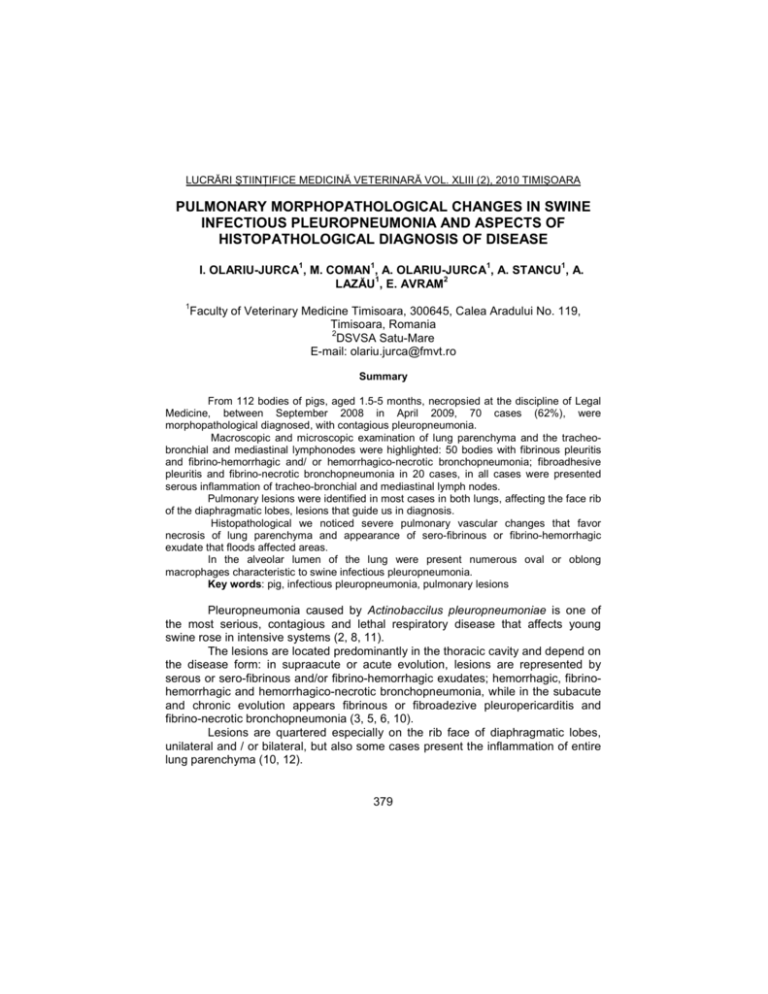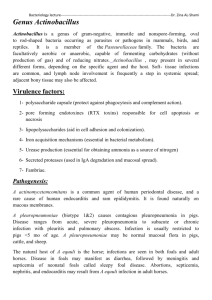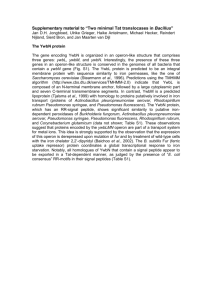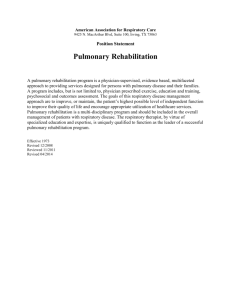pulmonary morphopathological changes in swine infectious
advertisement

LUCRĂRI ŞTIINłIFICE MEDICINĂ VETERINARĂ VOL. XLIII (2), 2010 TIMIŞOARA PULMONARY MORPHOPATHOLOGICAL CHANGES IN SWINE INFECTIOUS PLEUROPNEUMONIA AND ASPECTS OF HISTOPATHOLOGICAL DIAGNOSIS OF DISEASE 1 1 1 1 I. OLARIU-JURCA , M. COMAN , A. OLARIU-JURCA , A. STANCU , A. 1 2 LAZĂU , E. AVRAM 1 Faculty of Veterinary Medicine Timisoara, 300645, Calea Aradului No. 119, Timisoara, Romania 2 DSVSA Satu-Mare E-mail: olariu.jurca@fmvt.ro Summary From 112 bodies of pigs, aged 1.5-5 months, necropsied at the discipline of Legal Medicine, between September 2008 in April 2009, 70 cases (62%), were morphopathological diagnosed, with contagious pleuropneumonia. Macroscopic and microscopic examination of lung parenchyma and the tracheobronchial and mediastinal lymphonodes were highlighted: 50 bodies with fibrinous pleuritis and fibrino-hemorrhagic and/ or hemorrhagico-necrotic bronchopneumonia; fibroadhesive pleuritis and fibrino-necrotic bronchopneumonia in 20 cases, in all cases were presented serous inflammation of tracheo-bronchial and mediastinal lymph nodes. Pulmonary lesions were identified in most cases in both lungs, affecting the face rib of the diaphragmatic lobes, lesions that guide us in diagnosis. Histopathological we noticed severe pulmonary vascular changes that favor necrosis of lung parenchyma and appearance of sero-fibrinous or fibrino-hemorrhagic exudate that floods affected areas. In the alveolar lumen of the lung were present numerous oval or oblong macrophages characteristic to swine infectious pleuropneumonia. Key words: pig, infectious pleuropneumonia, pulmonary lesions Pleuropneumonia caused by Actinobaccilus pleuropneumoniae is one of the most serious, contagious and lethal respiratory disease that affects young swine rose in intensive systems (2, 8, 11). The lesions are located predominantly in the thoracic cavity and depend on the disease form: in supraacute or acute evolution, lesions are represented by serous or sero-fibrinous and/or fibrino-hemorrhagic exudates; hemorrhagic, fibrinohemorrhagic and hemorrhagico-necrotic bronchopneumonia, while in the subacute and chronic evolution appears fibrinous or fibroadezive pleuropericarditis and fibrino-necrotic bronchopneumonia (3, 5, 6, 10). Lesions are quartered especially on the rib face of diaphragmatic lobes, unilateral and / or bilateral, but also some cases present the inflammation of entire lung parenchyma (10, 12). 379 LUCRĂRI ŞTIINłIFICE MEDICINĂ VETERINARĂ VOL. XLIII (2), 2010, TIMIŞOARA Materials and methods Morphopathological research, macroscopic and microscopic exams, were made following necropsy at the discipline of Forensic Medicine, from 112 bodies of pigs, aged 1,5-5 months, from the farm with intensive growth in Timis County. Following macroscopic examination of the lung, in 70 cases (62%) on the costal face of diaphragmatic lobes, were noted lesions of hemorrhagic, fibrinohemorrhagic, hemorrhagico-necrotic and fibrino-necrotic bronchopneumonia. This location of lesions guides us in diagnosis of swine infectious pleuropneumonia. For histopathological confirmation of the necropsic diagnosis, we sampled (tissue - 2 / 0, 5cm) of lymph nodes and tracheo-pulmonary lesions. Samples were fixed in formaldehyde 10% soil, and then processed by paraffin technique, sectioned at 6 µm and colored by the HEA method. Histopathological samples obtained, were examined microscopically, with increasing targets, interpreted and then the most characteristic lesions were microphotographed. Results and discussions At the external examination of the corpses we noted, in most cases, the state of good maintenance, lack of skin elasticity, enoftalmy, skin cyanosis, conjunctival and oral mucosa cyanosis. At the internal examination, in the thoracic cavity we noted an appreciable amount of sero-hemorrhagic exudates (500 ml) with rare floaters of fibrin. Macroscopic, the lungs were increased in volume, with rounded edges and tense pleura. In 50 cases, aged 1.5-5 month, on the rib face of the diaphragmatic lobes, the inspection and the section revealed numerous red-cherry, dry, compact areas covered by an yellowish gray membrane and fibrinous exudates, fibrinohemorrhagic pleuro-bronchopneumonia. In 20 cases, in both lungs, predominant on the face rib of diaphragmatic lobes, were observed blackish red areas surrounded by a gray-white belt of fibroconjuctival reaction. Section of affected area revealed color, aspect and consistence changes (birch color, dry aspect and increased consistence). Docimasia were positive. Between parietal pleura and serous thoracic cavity were present adherent membrane strongly anchored to the wall rib. Microscopic examination revealed: pulmonary alveolar necrosis nearby dilatated lymphatic vessels (Fig. 1); heads- looking cells in the lumen of alveoli necrosis (Fig. 20; fibrino-hemorrhagic exudates in the lumen of pulmonary alveoli and interstitium (perilobular) (Fig. 3); peeling respiratory epithelium; hypertrophied pleura (Fig. 4); capillares of the alveolar septa were more dilated by conglutinate platelets, red blood cells, granulocytes, neutrophils and microtrombosis (Fig. 5). 380 LUCRĂRI ŞTIINłIFICE MEDICINĂ VETERINARĂ VOL. XLIII (2), 2010 TIMIŞOARA These vascular changes favor local necrosis of pulmonary tissue, and flood affected areas with sero-fibrinous and fibrino-necrotic exudates (Fig. 6). These modified structural aspects, reported in the literature as characteristic to swine infectious pleuropneumonia, are common in acute and subacute evolution of disease and translated by fibrino-hemorrhagic and hemorrhagico-necrotic bronchopneumonia (1, 4, 9). Elongated/ellipsoidal shape of alveolar macrophages is due to exotoxins action produced by Actinobacillus pleuropneumoniae and represents clear evidence of histopahological diagnosis in swine infectious pleuropneumonia (2, 10, 12). Fig. 1. Pulmonary alveolar necrosis nearby dilatated lymphatic vessels. HEA. x 100 Fig. 2. Heads-looking cells in the lumen of alveoli necrosis. HEA x 400 Fig. 3. Fibrino- hemorrhagic exudates in the lumen of pulmonary alveoli and alveoli necrosis. HEA x 100 Fig. 4. Hypertrophied pleura, dilatated lymphatic vessels and alveoli necrosis. HEA x 100 381 LUCRĂRI ŞTIINłIFICE MEDICINĂ VETERINARĂ VOL. XLIII (2), 2010, TIMIŞOARA Fig. 5. Intravascular microtrombosis, pulmonary alveolar necrosis and alveolar emphysema. HEA x 100 Fig. 6. Fibrino-necrotic exudates in the lumen of pulmonary alveoli. HEA x 100 Conclusions Swine infectious pleuropneumonia were macroscopically and microscopically diagnosed, at 70 pigs (62%) aged 1.5-5 months from 112 corpses necropsied at the Forensic Discipline. In 50 cases the disease was acute or supracute and gross lesions identified were represented by fibrinous and/ or fibrino-hemorrhagic pleuritis, hemorrhagic and hemorrhagic–necrotic bronchopneumonia and serous tracheo and mediastinal lymph nodes. Pleuritis and/or fibroadhesive pleuropericarditis and fibrino-necrotic bronchopneumonia were observed in 20 cases of subacute and chronic evolution. Histopathological lesions observed were: hypertrophied pleura covered by a cellular fibrin exudate; alveolar necrosis nearby lymph vessels dilated by the accumulation of fibrin, blood elements and limph- monocytes; pulmonary alveoli overloaded with heads-looking cells and fibrino-hemorrhagic exudates; respiratory epithelium peeling, sharp demarcation of the lung lobes by a rich gap infiltrated with a cellular fibrin exudate. References 1. Baarsch, M.J., Scamurra, R.W., Burger, K., Foss, D.L., Maheswaran, S.K., Murtaugh, M.P., Inflammatory citokine expression in swine experimentally infected with Actinobacillus pleuropneumoniae, Infect.Immun., 1995, 63(9), 3587. 2. Baba, A.I., Diagnostic necropsic veterinar, Ed. Ceres, Bucureşti, 1996. 382 LUCRĂRI ŞTIINłIFICE MEDICINĂ VETERINARĂ VOL. XLIII (2), 2010 TIMIŞOARA 3. Bertam, T.A, Pathobiology of Acte Pulmonary Lesions In swine Infected with Haemophilus (Actinobacillus) pleuropneumoniae, Canal Vet. Journal, 1988, 20, 574. 4. Cho, W. S., Chae, C., Expression of Apx IV gene in pigs naturally infected with Actinobacillus pleuropneumoniae, Journal Comp Pathology, 2001, 125, 34-40. 5. Huang, H., Potter, A., Campos, M., Leighton, F.A., Willson, P.J., Haines, D.M., Yates, W.D., Pathogenesis of porcine Actinobacillus pleuropneumonie; part II: roles of proinflammatory cytokines. Can. J. Vet. Res., 1999, 63(1), 69. 6. Jaques, M., Blanger, M., Roy, G., Foiry, B., Adherence of Actinobacillus pleuropneumoniae to porcine tracheal epithelial cells and frozen long sections, Vet. Microbiology, 1991, 27, 133-143. 7. Mills, A., N., Haaworrth, S., G., Pattern of connective tissue development in swine pulmonary vasculature by imunolocalization, J. Pathology, 1987, 153, 171-176. 8. Moga Manzat, R., Tataru, Domnica., Diagnosticul pleuropneumoniei infectioase a porcului. Rev. de crest. anim., 1982, 11, 39. 9. Overbeke Van, Ingrid., Chiers, K. Charlier, G., Vandenberghe, Isabel., Beeumen Van, J., Ducatelle, R., Haesenbrouck, F., Characterization of the in vitro adhesion of Actinobacillus pleuropneumoniae to swine alveolar epithelial cells. Vet. Microbiol., 2002, 88, 1, 59. 10. Paul, I., Etiomorfopatologia bacteriozelor la animale, Qira, Iaşi, 2005. 11. Popoviciu, A., Macarie, I., Togoe, I., Pleuropneumonia contagioasa a porcului. Culeg. de Med. Vet., 1981, 5, 108. 12. ***- Actinobacillus Pleuropneumonia - www.thepigsite.com/diseaseinfo /4/actinobacillus -pleuropneumonia-app (accessed in 07.04.2010). 383







